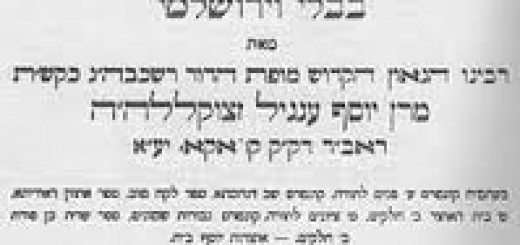To view as Pdf click here
By Rabbi Dovid Markel
Although modern western culture celebrates homosexual relationships, parading their sexual choices and proclivities through the streets of cities throughout the western world, the Torah is abundantly clear that such acts are a complete perversion of true sexual ethos.
The Torah (Vayikra 20:13) states: “And a man who lies with a male as one would with a woman, both of them have committed an abomination; they shall surely be put to death; their blood is upon themselves.”
It is impossible, in this short article, to deal with every aspect of this discussion—which is emotionally charged, no matter which side of the debate the person stands. However, we will nevertheless attempt to deal with the reason why the Torah states that they “have committed an abomination,” although this is not the standard expression the Torah uses—even when discussing a sinner[1]. Hopefully, this article will articulate something valuable in the cacophony of opinions that surround this topic.
In order to appreciate why homosexuality is antithetical to Torah values, it is important to preface with at least a short introduction concerning Judaism’s attitude to sexuality from the onset.
While there are various nuanced opinions, they generally can be classified into two sentiments: Maimonides believed that sexuality is a necessary evil for the purpose of procreation, while Nachmanides believed that it can be intrinsically holy.
Maimonides expressed his stance in the following statement:[2]
“The sense of touch, which is a disgrace to us…and which is the cause of our desire for eating, drinking, and sensuality. Intelligent persons must, as much as possible, reduce these wants, guard against them, feel grieved when satisfying them, abstain from speaking of them, discussing them, and attending to them in company with others. Man must have control over all these desires, reduce them as much as possible, and only retain of them as much as is indispensable.”
Nachmanides, though, was of the opposing view, saying:[3]
“You should know that this joining is holy and innocent when it will be according to what is proper; in the proper time and the proper intention. One should not think that there is any disgrace or ugliness in it—G-d forbid…It is not like the Rav thought in his Guide to the Perplexed—in his praise of Aristotle—that sensuality is a disgrace for us… It is like what the Rabbis said:[4] “When a person joins with his wife in holiness and purity, the Divine Presence dwells between them…” However, if their intention is not for holy conjoining but rather for the fulfilment of their pleasure…it departs from them.”
Already though, in these two opinions as to the purpose of sexuality is the perversion of homosexuality clear.
According to Maimonides, who believes that the act by its very nature is degrading and is only condoned for propagating the species, it is understood why he philosophically is revolted by homosexuality. While Nachmanides does not frown upon the essential act, when a person does not perform it for a holy purpose, they have taken something holy and completely desecrated it.
While even in heterosexual relationships an individual may not reach the holiness demanded by Nachmanides, it is intrinsically impossible in a homosexual one—and therefore forbidden.
It is with this preface that we can investigate the crux of the issue.
An abomination
Concerning homosexual relations, the Torah states that they “have committed an abomination.” The actual word that the Torah uses is to’eiva. The Talmud recounts an interesting anecdote to explain the meaning of this word[5].
“Ben Eleasa, a very wealthy man, was Rabbi’s son-in-law, and he was invited to the wedding of R. Shimon ben Rabbi. [At the wedding] Bar Kappara asked Rabbi, What is meant by to’evah? Now, every explanation offered by Rabbi was refuted by him, so he said to him, ‘Explain it yourself.’ He replied. ‘Let your housewife come and fill me a cup.’ She came and did so, upon which he said to Rabbi, ‘Arise, and dance for me, that I may tell it to you.’ Thus saith the Divine Law, ‘to’evah’: to’eh attah bah—thou errest in respected to her.”
Rashi,[6] the foremost Talmudic commentator, explains the error to mean that “forsaking the permitted and indulging in the forbidden,” is the essential error in regard to homosexuality.
While the simple meaning is that it is somehow repulsive because of this error, it does not explain why the fact that a person “forsakes the permitted for the forbidden” is any more revolting than any other sin where a person does the same.
We would like to postulate that the error which Rashi is referring to is a deeper one—that he is pointing out the axiomatic error of a person in a homosexual relationship.
Being One
In the biblical description of the first union, the Torah states:[7] “Therefore, a man shall leave his father and his mother, and cleave to his wife, and they shall become one flesh.”
Being that this statement of “therefore” is preceded by the description of the manner in which Eve was created—out of the flesh of Adam—Alshich[8] explains that the reason that man and woman should return to that union, is because originally they began as one creature:
“Therefore—because Adam and Eve were originally united—every man shall . . . cleave to his wife and become one flesh.”
Indeed, Talmud[9] and Medrash[10] explain that the original man was a composite creature of both male and female and was then later separated:
“When G‑d created the first human, He created him with two faces. Then He split them and created two backs, a separate back for each.”
This idea is similarly expressed in the Talmud’s statement:[11] “Any man who has no wife is no man; for it is said, ‘Male and female created He them and called their name Adam.’”
Marriage is not only two people coming together in love, it is the reunification of two people, returning to the original way that they were created. Without it, they are actually less human, as the male half is missing the female dimension of his soul and body and vice versa.
Thou Errest
Modern western culture is not the first to condone homosexual behavior, as such actions were tacitly sanctioned by both the Greeks and the Romans. However, throughout history, the reasoning to endorse such actions has always varied.
Perhaps it is to each of these groups and mind-sets that the Torah cries, “thou errest,” and declares they make a mockery and abomination concerning the essential purpose and holiness of sexuality.
In Plato’s Symposium, when describing the nature of eros, Aristophanes uses the following myth to describe the science behind love:
The original human nature was not like the present, but different. The genders were not two as they are now, but originally three in number; there was man, woman, and the union of the two, having a name corresponding to this double nature, which had once a real existence, but is now lost, and the word ‘Androgynous’ is only preserved as a term of reproach. …The primeval man…had four hands and four feet, one head with two faces, looking opposite ways…two privy members, and the remainder to correspond…Now the genders were three… I will cut them in two and then they will be diminished in strength and increased in numbers… They shall walk upright on two legs… Each of us when separated, having one side only, like a flat fish, is but the indenture of a man, and he is always looking for his other half…
While Aristophanes’ description is reminiscent of the Medrashic explanation for marriage—in that it is about two people that were originally one, looking for their other half—there is however, a focal difference.
In the Greek myth, the genders were three: One was composed of two males, one of two females and the last of a male and a female. It is entirely possible that although their culture retained a memory of the creation story, it was corrupted over millennia.
According to their distorted version, it is plausible that one’s “other half” can be of the same gender—and consequently there is nothing inherently wrong with homosexuality.
Torah turns to this group and states, “thou errest in regard to her.” In truth, original man was a composite of male and female and therefore, only a male and female, bound in marriage, can return to that unity.
The Romans too, had their own version of sexuality. In their minds, male and female were not biological definitions but emotional ones. In their perverted view of sexuality that revolved around domination, the dominant partner was considered male and the vulnerable partner female—no matter the biological gender.
To this distorted ideal of sexuality Torah turns as well, with the declaration that sexuality is not the expression of power but instead, two people becoming one in a wholesome and healthy manner. This was impossible in their warped version of sexuality.
Last, but most pertinent to our times, are the modern claims to defend homosexuality. They as well make two claims: A) Sexuality is about love and one can love a member of the same gender just as much as someone from another, or B) that it is about pleasure, and another person has no right to prohibit the pleasure of another.
Pleasure however, and even love, is not the purpose of marriage or sexuality but merely a by-product of it. Focusing on pleasure is antithetical to conjoining as one—as the focus on each person’s selfish pleasure is the ultimate litmus test that they are not focusing on unity but rather themselves.
While love in marriage is strived for, it is but the glue that ensures unity, not unity in its own right. The unity that is demanded from partners in marriage is not merely a romantic love that binds two separate individuals together—but a unity of two souls and two bodies that were formerly one, now returning to their original state.
It is pertaining to all these aspects of sexuality that the Torah states that homosexuality is an abomination.
The atrocity is not an emotional homophobia but a disgust in the axiomatic ethos of homosexuality; one which transforms the holiest act of intimacy—G-d’s vessel to express the greatest blessing of childbirth—into the mundane or even the vulgar.
Concerning holy unity the Zohar states:[12]
“It is written (Iyov 23:13): “He is in one…” “[He is] in one”? Should it not read, “[He] is one”? [The meaning of this verse is that] G-d only abides and dwells “in one,” in the person who achieves a holy oneness—nowhere else. When is a person called “one?”… When a person is in the union of intimacy… When male and female join, they become one. They are one in body and one in soul; they are one person. And G-d dwells in the oneness.”
May we indeed experience holy unions and may G-d truly dwell in each of our homes in a manner in which His presence will be completely expressive and comfortable!
[1] There are an additional 12 time where the Torah uses this expression but it is clearly not standard even concerning sin.
[2] Guide to the Perplexed 3:8.
[3] Igeres HaKodesh, Ramban. There are those that question the veracity of whether this letter was actually authored by the Ramban or if it was written by a different Talmudic sage.
[4] Talmud Sotah 17a.
[5] Talmud, Nedarim 51a.
[6] Ad loc.
[7] Bereishit 2:23-24.
[8] Ad loc.
[9] Talmud, Shabbos 61a.
[10] Bereishis Rabba 8:1.
[11] Yevamot 63a.
[12] Zohar 3:80a-b.






















